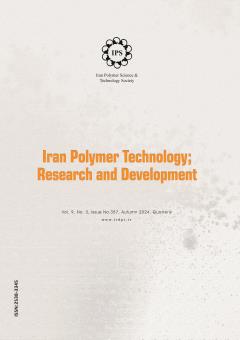چندسازههای پلیمر/چارچوب آلی کووالانسی هترو ساختار: پیشرفتهای اخیر و کاربردهای آن
الموضوعات :
1 - دانشگاه مازندران
2 - دانشگاه مازندران
الکلمات المفتاحية: پلیمر, چارچوب آلی کووالانسی, چندسازه, هترو ساختار,
ملخص المقالة :
مواد متخلخل، بهدلیل داشتن ویژگیهای قابلتوجه مانند ساختار خاص و ویژگیهای منحصر به فرد، برای صنعت و زندگی روزمره، ضروری هستند. بهطور کلی مواد جامدی که در ساختارشان حاوی حفره و منفذ هستند به عنوان مواد متخلخل تعریف میشوند. یکی از مفاهیم مهمی که در مواد متخلخل مورد بررسی قرار میگیرد تخلخل میباشد. تخلخل از تقسیم حجم حفرات به حجم کلی ماده بدست میآید. حفرات موجود در مواد متخلخل به دو نوع حفرات باز و حفرات بسته تقسیم میشوند. حفرات باز به سطح ماده دسترسی دارند ولی حفرات بسته در درون ماده محبوس هستند. اخیراً، به دلیل ویژگیهای برتر این مواد، توسعه مواد متخلخل نوظهور برای کاربردهای بین رشتهای، رشد چشمگیری داشته است. چارچوبهای آلی کووالانسی (Covalent Organic Frameworks)، با داشتن ویژگیهایی مانند قابلیت طراحی، سطح وسیع و تخلخل بالا، بهعنوان یک زیرساخت جدید و عالی برای محصولات کریستالی متخلخل، توجه محققان زیادی را به خود جلب کردهاند. برای بهبود رفتار COFهای اولیه، ادغام COFها با سایر مواد ، برای تشکیل چندسازههای مشتق شده، ضروری است. در این مقاله، پیشرفتهای اخیر درمورد چندسازههای هتروساختاری ساخته شده از طریق ادغام پلیمرها با COFها را به منظور بکارگیری در کاتالیزگرها، جداسازی گاز، ذخیرهسازی انرژی، جذب، تشخیص شیمیایی، تصویربرداری زیستی، فوتودرمانی و ایمنی مواد غذایی، ارائه خواهد شد. علاوه بر این، چالشهای ذاتی و چشماندازهای توسعه چندسازههای مبتنی بر COF نیز، ذکر خواهد شد.
1. Ding S.Y., Gao J., Wang Q., Zhang Y., Song W. G., Su C. Y., Wang W., Construction of covalent organic framework for
catalysis: Pd/COF-LZU1 in Suzuki–Miyaura coupling reaction, Journal of the American Chemical Society, 133, 19816-19822, 2011. 2. Geng K., He T., Liu R., Dalapati S., Tan K.T., Li Z., Jiang D., Covalent organic frameworks: design, synthesis, and functions,
Chemical reviews, 120, 8814-8933, 2020. 3. Beagle L.K., Moore D.C., Kim G., Tran L.D., Miesle P., Nguyen C., Glavin N.R., Microwave facilitated covalent organic
framework/transition metal dichalcogenide heterostructures, ACS Applied Materials & Interfaces, 14, 46876-46883, 2022. 4. Zhang G., Hong Y.L., Nishiyama Y., Bai S., Kitagawa S., Horike S., Accumulation of glassy poly (ethylene oxide) anchored
in a covalent organic framework as a solid-state Li+ electrolyte, Journal of the American Chemical Society, 141, 1227-1234, 2018. 5. Zhu C., Pang S., Chen Z., Bi L., Wang S., Liang C., Qin C., Synthesis of covalent organic frameworks (COFs)-nanocellulose
composite and its thermal degradation studied by TGA/FTIR, Polymers, 14, 3158, 2022. 6. Xie Z., Wang B., Yang Z., Yang X., Yu X., Xing G., Chen L., Stable 2D heteroporous covalent organic frameworks for
efficient ionic conduction, Angewandte Chemie International Edition, 58, 15742-15746, 2019. 7. Zhang G., Li X., Liao Q., Liu Y., Xi K., Huang W., Jia, X., Water-dispersible PEG-curcumin/amine-functionalized covalent
organic framework nanocomposites as smart carriers for in vivo drug delivery, Nature Communications, 9, 2785, 2018. 8. Mulzer C.R., Shen L., Bisbey R.P., McKone J.R., Zhang N., Abruña H.D., Dichtel W.R., Superior charge storage and power
density of a conducting polymer-modified covalent organic framework. ACS central science, 2, 667-673, 2016. 9. Yang J., Xie C., Yang Q., Wang S., Gao Y., Ji J., Sun D., PANa/Covalent organic framework composites with improved water
uptake and proton conductivity, Chemical Communications, 58, 1131-1134, 2022. 10. Sun Q., Tang Y., Aguila B., Wang S., Xiao F.S., Thallapally P.K., Ma S., Reaction environment modification in covalent
organic frameworks for catalytic performance enhancement, Angewandte Chemie International Edition, 58, 8670-8675, 2019. 11. Liu Y., Zhou W., Teo W.L., Wang K., Zhang L., Zeng Y., Zhao Y., Covalent-organic-framework-based composite materials,
Chem, 6, 3172-3202, 2020. 12. Wang Y., Xie M., Lan J., Yuan L., Yu J., Li J., Shi W., Radiation controllable synthesis of robust covalent organic framework
conjugates for efficient dynamic column extraction of 99TcO4−, Chem, 6, 2796-2809, 2020. 13. Liu S., Wang M., He Y., Cheng Q., Qian T., Yan C., Covalent organic frameworks towards photocatalytic applications:
Design principles, achievements, and opportunities, Coordination Chemistry Reviews, 475, 214882, 2023. 14. Li J., Cheng Z., Wang Z., Dong J., Jiang H., Wang W., Zhu G., Ultramicroporous covalent organic framework nanosheets
with functionality pair for membrane C2H2/C2H4 separation, Angewandte Chemie, 135, e202216675, 2023. 15. DeBlase C.R., Hernández-Burgos K., Silberstein K.E., Rodríguez-Calero G.G., Bisbey R.P., Abruña H.D., Dichtel W.R., Rapid
and efficient redox processes within 2D covalent organic framework thin films, ACS nano, 9, 3178-3183, 2015. 16. Zheng L., Song Q., Tan P., Wang S.T., Liu X.Q., Sun, L.B., Endowing covalent organic frameworks with photoresponsive
active sites for controllable propylene adsorption, Small, 19, 2207291, 2023. 17. Xie Y., Chen Y., Sun X., Wang Y., Wang Y., Conducting polymer engineered covalent organic framework as a novel
electrochemical amplifier for ultrasensitive detection of acetaminophen, Chinese Chemical Letters, 32, 2061-2065, 2021. 18. You J., Yuan F., Cheng S., Kong Q., Jiang Y., Luo X., Zhang C., AIEgen-based Sp2 carbon-conjugated covalent organic frameworks with high stability and emission for activatable imaging and ferroptosis in target tumor cells, Chemistry of
Materials, 34, 7078-7089, 2022. 19. Chen H., Gu Z.G., Zhang J., Chiral-induced ultrathin covalent organic frameworks nanosheets with tunable circularly
polarized luminescence, Journal of the American Chemical Society, 144, 7245-7252, 2022. 20. Guo X., Mao T., Wang Z., Cheng P., Chen Y., Ma S., Zhang Z., Fabrication of photoresponsive crystalline artificial muscles
based on pegylated covalent organic framework membranes, ACS Central Science, 6, 787-794, 2020. 21. Huang Y., Feng D., Li X., Li W., Ren J., Zhong H., Covalent organic frameworks assisted for food safety analysis, Critical
Reviews in Food Science and Nutrition, 1-20, 2023. 22. Hu K., Wang Y., Wang G., Wu Y., He Q., Research progress of the combination of COFs materials with food safety
detection, Food Chemistry, 136801, 2023.


